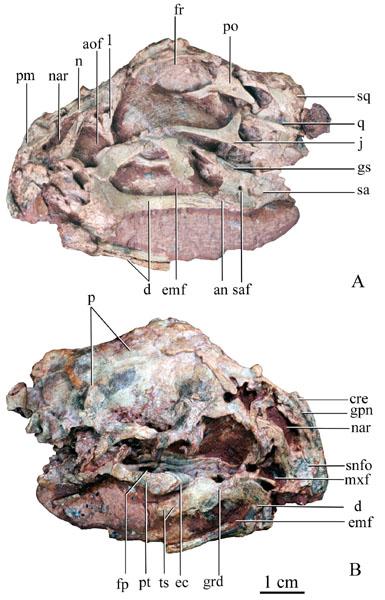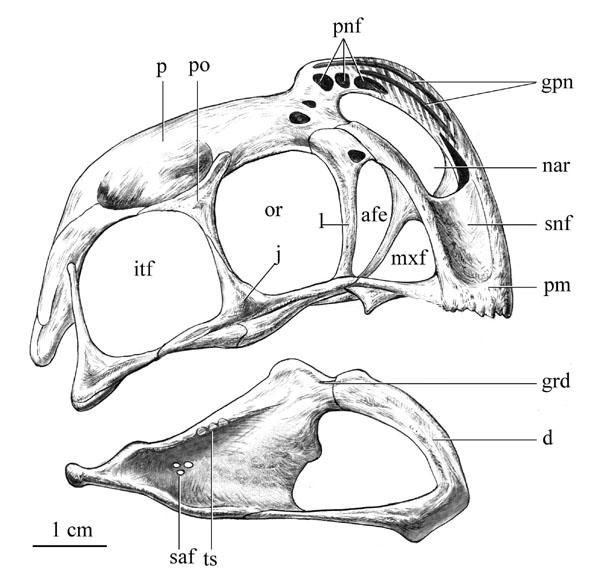The oviraptorids are a theropod group in which the kull and mandible are highly modified, and are characterized by a short snout, the absence of teeth, a tall mandible, a long parietal, an enlarged tooth-like process on the palate, and a large, anteriorly located external mandiblar fenestra. Ten oviraptorid taxa have been reported from Late Cretaceous deposits in Asia so far.
Dr. XU Xing and his Ph. D. student, HAN Fenglu, Institute of Vertebrate Paleontology and Paleoanthropology, Chinese Academy of Sciences, recently reported a new oviraptorid taxon, Banji long gen. et sp. nov., based on a nearly complete skull and mandible which was possibly collected from the Upper Cretaceous Nanxiong Formation of Ganzhou, Jiangxi, China in the Journal of Vertebrata PalAsiatica, 2010. This new finding not only adds to the known diversity of Late Cretaceous oviraptorids, but provides significant new information on the evolution of some oviraptorid features.
Dr. XU Xing and his Ph. D. student, HAN Fenglu, Institute of Vertebrate Paleontology and Paleoanthropology, Chinese Academy of Sciences, recently reported a new oviraptorid taxon, Banji long gen. et sp. nov., based on a nearly complete skull and mandible which was possibly collected from the Upper Cretaceous Nanxiong Formation of Ganzhou, Jiangxi, China in the Journal of Vertebrata PalAsiatica, 2010. This new finding not only adds to the known diversity of Late Cretaceous oviraptorids, but provides significant new information on the evolution of some oviraptorid features.

Fig.1: Holotype of Banji long gen. et sp. nov., IVPP V 16896, in left (A) and right (B) lateral view (Courtesy of Dr. XU Xing)
Banji long is distinguishable from other species based on the following features: a crest formed by the premaxillae and nasals having a step-wise posterior end and bearing two longitudinal grooves and numerous oblique striations on each of its lateral surfaces, an extremely elongate external naris that is posteriorly situated and close to the orbit, a deep fossa on the dorsal surface of the palatal ramus of the pterygoid, several longitudinal grooves along the posterior part of the dorsal margin of the dentary, and several tubercles along the lateral shelf at the dorsal margin of the surangular.

Fig.2: Reconstruction of Banji long gen. et sp. nov. in lateral view (Courtesy of Dr. XU Xing)
"Banji long possesses some palatal and mandibular features not seen in other oviraptorids but similar to those in more basal oviraptorosaurs, suggesting a relatively basal position within the Oviraptoridae, said Dr. XU Xing, This systematic hypothesis is supported by a numerical cladistic analysis. Doubtlessly, Banji long would provide some critical new information about the morphological evolution of the group and probably help understanding oviraptorid ontogeny.
Related News
Photos
More>>trade
market
- Updated: Study Shows Paleolithic Culture in Japan May Originate from North China
- Ceratopsid Dinosaur First-ever Found in China
- Chinese Dinosaur Fossils Make North America Debut in Cincinnati
- Human Remains from China Indicate Modern Human Emerged Much Earlier Than
- CAS to Strengthen International Cooperation in 12th Five-year Plan Period





